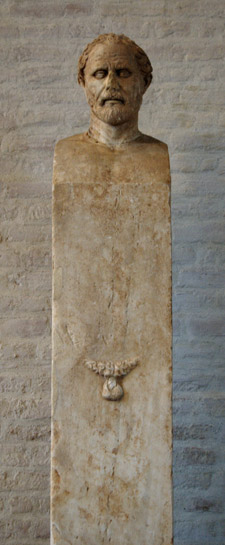 |
| Herma of Demosthenes, c. 280 BC click to embiggen |
wiki describes a herma as "a sculpture with a head, and perhaps a torso, above a plain, usually squared lower section, on which male genitals may also be carved at the appropriate height... and were placed at crossings, country borders and boundaries as protection (against evil)"
(note to self: evil is afraid of penises)
The article doesn't really answer why a herma consists of a rectangular block with such a limited set of sculptural elements.
Possible reasons :
- Importance. Sculptors sought to simplify man to only the most important elements.
- A solid rectangular block would be more resilient than a full figure but then the point of adding fragile genitals (see the broken bits in the photo above) brings that theory into question.
- Identification. If someone doesn't recognize the face maybe they'd recognize another part.
- Vandals. Who has never seen a dumpster or wall that a vandal has drawn a penis on to it? I imagine industrious sculpting vandals with chisel in hand sneaking out to the herma in the dark of night and chipping away until they've added a phallus.
- the rectangular block below the head could serve a sign space – like a modern sandwich board.
- many phalluses have, over the years, been broken. Perhaps they pointed a direction
- for those hermas erected erect, they could serve as a way to protect Greek towns from roving bands of nymphomaniacs (this assumes there were actually roving bands of nymphos who could be distracted by the herma just outside of town)


No comments:
Post a Comment